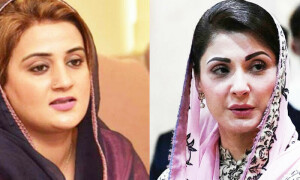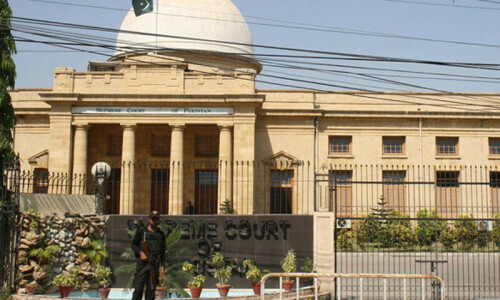Projects like Bahria Town ‘are atom bombs for the poor’

KARACHI: Towns such as Bahria coming up in the rural areas around the city will change the demographics of Karachi. They are a big game being played in the name of development; they bulldoze the rights of the indigenous people and are like atom bombs to wipe off the poor population of this country.
These were some of the views expressed by writers, historians, researchers and experts at a seminar, ‘Bahria Town: Development or Destruction’, organised by Save Sindh Committee at PMA House here on Monday.
“Malik Riaz did not own even an inch of land when announcing the Bahria Town project and yet he collected billions through bookings. The land came later thanks to some big bribes for politicians,” said historian and chronicler Gul Hasan Kalmati.
“Today, work is under way on 23,300 acres though the target is grabbing 43,000 acres of land for this project because already we can see activities beyond the boundaries where there are some eight to nine Goths, or villages. Actually, their activities affect 45 such villages as their animals can no longer graze inside the boundary, etc,” he explained the repercussions that, according to the expert, were only just the ‘tip of the iceberg’.
“It is obvious why the PPP and PML-N have turned a blind eye towards Bahria Town but why are the sardars quiet?” said Kalmati. “That is because they have also been bought. Ten per cent from Bahria Town goes directly into their pockets,” he answered his own question. “The sardars are so powerful that had they wanted, there would have been no Bahria Town.”
“There are some 30 projects around the Superhighway that have been on hold for years due to the issue of utilities such as water and power reaching there. But for Bahria Town everything has been arranged, like getting power by laying a cable from Gadap and water lines and boring water that was meant for agriculture, and for which even a company as big as Nestle was not allowed to operate from there, is now diverted towards the town,” Kalmati said.
Architect, development expert and town planner Arif Hasan said that the rural areas around Karachi were reserved for agriculture in the first plan of Karachi in 1953, something that was repeated in the 1958 plan and the 1989 plan for 2000. “Some work on this started, too, but then it stopped due to pressure from land-grabbers,” he said.
About all this land being developed for townships for the elite, Arif Hasan shared that 350,000 plots lay vacant in Karachi. “This is how the rich invest, by holding land. Phase eight in the DHA was started some 28 years ago and most of it still remains bare. Now we are told that two million people will live in DHA City and 3.5 million will live in Bahria Town. Will they all come and live there like they do in Phase eight of the DHA? Live there or not, they will own land there, of course,” the development expert explained.
“Malik Riaz was able to acquire the most land here. He also has projects in Lahore and Islamabad but some transparency still exists there to stop him from having his way,” he said.
Arif Hasan had a few suggestions that can stop such high profile land-grabbers from having their way such as not allowing anyone to own more than 500 yards, not giving loan for constructing a house to anyone twice and heavy fee or tax on non-utilisation of land. “But will our assemblies pass such laws?” he said.
Finally, Baloch leader and president of the Awami Workers Party Yousuf Masti Khan said that Sindh’s weakness lay in its feudals willing to do anything to remain powerful. “But we the middle class and the poor must struggle against such elements. Your land is your ‘mother’. Do not let go of it so easily. Guard it with your life,” he said.
“Make no mistake about it. This is investment, not development. Had it been development, we would have seen the building of schools and hospitals for the indigenous people of these areas. Instead they are being driven away. Bahria Town and others like it are atom bombs for wiping out the poor,” he said.
Writer and columnist Abdul Khaliq Junejo and researcher and journalist Fahim Zaman also spoke.
Published in Dawn, May 17th, 2016













































